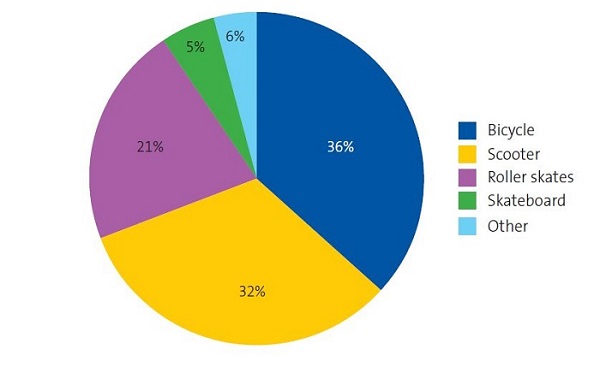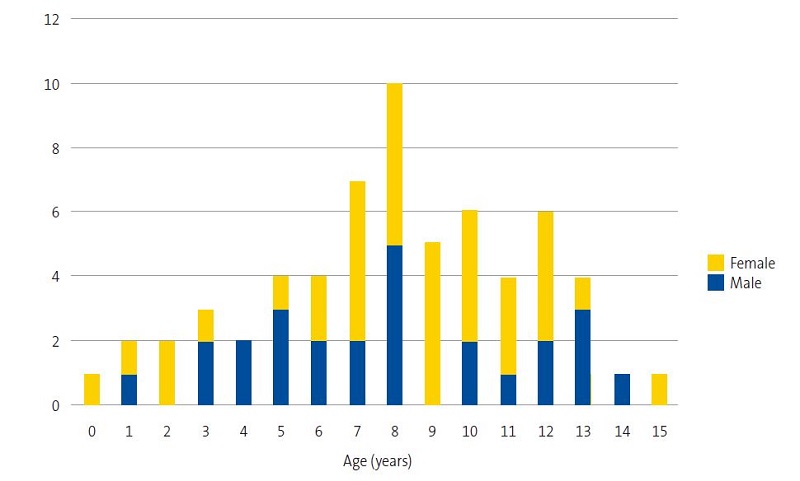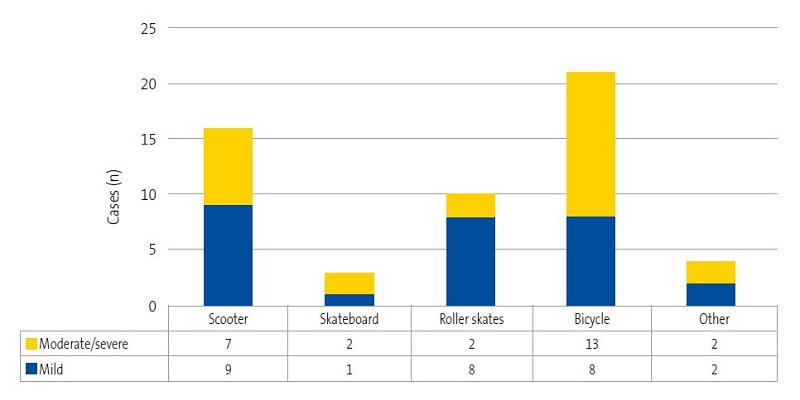Vol. 23 - Num. 91
Original Papers
Impact of deconfinement due to the COVID-19 pandemic on the trauma pattern observed in an emergency department
Julia Saiz Alíaa, M.ª Teresa Moreno de Guerra Beatoa, M.ª Teresa Porter Almaraza, David Tejero Sáncheza, Javier Miranda Barriosa, Miguel Ángel Molina Gutiérrezb, Marta Plata Gallardoc, Irene Martín Espínc
aMIR-Pediatría. Hospital Universitario Infantil La Paz. Madrid. España.
bServicio de Urgencias Pediátricas. Hospital Universitario Infantil La Paz. Madrid. España.
cServicio de Pediatría. Hospital Universitario Infantil La Paz. Madrid. España.
Correspondence: J Saiz. E-mail: juliasaizalia@gmail.com
Reference of this article: Saiz Alía J, Moreno de Guerra Beato MT, Porter Almaraz MT, Tejero Sánchez D, Miranda Barrios J, Molina Gutiérrez MA, et al. Impact of deconfinement due to the COVID-19 pandemic on the trauma pattern observed in an emergency department. Rev Pediatr Aten Primaria. 2021;23:247-52.
Published in Internet: 01-09-2021 - Visits: 8877
Abstract
Introduction: after 42 days of lockdown imposed due to the global COVID-19 pandemic, children under 14 years were allowed to leave their homes. The aim of the study was to analyse the impact of the period following the lifting of confinement measures on traumatic injury trends in children.
Material and methods: we carried out a retrospective and observational study in children aged less than 16 years that presented with traumatic injuries to the emergency department of a tertiary care hospital between April 26 and the start of the scaling down in the Community of Madrid on May 24. We compared the frequency of traumatic injuries and fractures, the mechanism and site of injury and other variables to those recorded in the same period the year before.
Results: there was a significant increase in the proportion of fractures compared to 2019 (41.9 vs. 11.3%; p <0.001). The percentage of accidents related to wheeled vehicles was significantly higher in 2020 (43.9 vs. 6.2%; p <0.001), with these accidents most frequently involving bicycles (35.4%) and scooters (32.2%).
Conclusions: in the period following the lockdown, there was a remarkable increase in accidents related to wheeled vehicles in the paediatric population, although this outcome was probably influenced by specific organizational measures implemented in Madrid in the period under study.
Keywords
● COVID-19 ● Lockdown ● Paediatric emergencyINTRODUCTION
Cases of coronavirus disease 2019 (COVID-19) caused by infection by the novel coronavirus SARS-CoV-2 were first detected in humans in December 2019 in the city of Wuhan, China.1 In mid-March 2020, the epidemic already affected more than 190 countries, leading the World Health Organization (WHO) to declare it a global pandemic and public health emergency.2
On January 31, 2020, the Centro Nacional de Microbiología (National Centre of Microbiology) confirmed the first positive SARS-CoV-2 case in Spain.3 One month and a half later, on March 14, 2020, the Spanish government declared a state of alert. As occurred in many other countries, one of the main measures taken to address the situation were population confinement measures.4
On April 26, 2020, after 42 days of home confinement, children under 14 years were allowed to go on walks out of doors for 1 hour a day, remaining in a 1 km radius from their homes; they could only be accompanied by an adult member of their household and were allowed to bring a ball, scooter, bicycle and other toys.
Although disease caused by SARS-CoV-2 infection was less severe in the paediatric population,5 children and adolescents started to show the negative effects of the prolonged lockdown.6-8
The aim of our study was to analyse the impact of lifting lockdown restrictions imposed on account of COVID-19 on traumatic injury trends in the paediatric population.
MATERIAL AND METHODS
We conducted a retrospective observational study in the paediatric emergency department (PED) of a tertiary care hospital in the Community of Madrid (Spain). The study was approved by the ethics committee of the hospital (file no. PI-4159).
We included patients aged less than 16 years that received care for traumatic injuries in our PED between April 26, 2020 and May 24, 2020, the date when the government of the Community of Madrid started scaling down measures of confinement and the restrictions of free movement and activity that had been imposed due to the public health crisis. We made comparisons with data corresponding to the same time period the year before.
We collected data from the electronic health record database (HP-CIS© 2013; Hewlett-Packard Development Company, LP). We obtained data that could not be found in the health records through telephone interviews with the patients.
We collected data on the following variables: sex, age, date of injury, date of medical visit, corresponding referral hospital, mechanism of injury, type of vehicle, site of injury, presence of wound, radiographic diagnosis, final diagnosis, treatment, need of sedation/analgesia, need of hospital admission and need of followup.
We have summarised qualitative data as absolute frequency and percentage distributions, and quantitative data as mean and standard deviation (SD). We compared frequencies in different groups by means of the chi square or Fisher exact tests. We defined statistical significance as p <0,05. The data were analysed with the statistical software SPSS version 21 (IBM, New York, USA).
RESULTS
In the period under study, our PED managed a total of 2225 patients, of who 10.6% presented with traumatic injuries. This amounted to a 1.9% increase compared to the same time period the year before, accompanied by a significant increase in the proportion of traumatic fractures (41.9% versus 11,3%; p <0.001).
The percentage of accidents involving wheeled vehicles was significantly higher in 2020 (43.9% versus 6.2%; p <0.001), and these accidents most frequently involved bicycles (35.4%) and scooters (32.2%) (Figure 1).
The mean age of this group of patients was 8 ± 3.5 years; 41.9% were male and 58.1% female. The male sex predominated among the youngest patients, but from age 6 years, a majority of patients were female (Figure 2).
In 53.2% of cases, the injuries were mild (superficial wounds, concussions and mild head injuries). Most fractures involved the long bones of the forearm (Table 1). Of all fractures in the extremities, 34.6% were considered complicated based on the need for open reduction or internal fixation; and 40.3% of cases required outpatient followup in the paediatric orthopaedics clinic.
| Table 1. Type of injuries managed | |
|---|---|
| Upper extremity fractures | Radius and ulna: 14/62 Clavicle: 3/62 Hand and fingers: 1/62 |
| Lower extremity fractures | Femur: 1/62 Foot and toes: 2/62 |
| Skull fracture | 3/62 |
| Tooth/mandible fractures | 2/62 |
| Wounds/concussion | 29/62 |
| Mild head injury | 4/62 |
| Other* | 2/62 |

The most severe injuries were due to scooter and skateboard accidents (Figure 3), including 2 of the 3 patients with severe traumatic brain injury associated with skull fracture.
DISCUSSION
Our study analysed the impact of the lifting of confinement measures on traumatic injuries in children, and found a significant increase in the overall frequency of fractures and injuries related to wheeled vehicles compared to the same time interval in 2019.
There is no question that the paediatric population has been affected significantly by the lockdown, especially at the behavioural level. On one hand, children and adolescents have experienced increased feelings of anxiety, powerlessness and fear.6-8 On the other hand, they have been deprived of the beneficial effects of the active social life that unfolds in the school setting on their personality and sense of self.9 All of these factors must have promoted conflict in the household, and there has been evidence of an increase in violence and abuse associated with being forced to be together during home confinement.9-11
A second negative consequence of the lockdown was the deterioration of the physical health of children, secondary to a decrease in the quality of nutrition12 and the replacement of active leisure activities with virtual activities.12,13
When it came to paediatric traumatic injuries, we observed 2 distinct trends. During the lockdown, consistent with what had been reported in adult patients by other authors,14 we found that parents delayed bringing their children to the emergency department, possibly out of fear of SARS-CoV-2 transmission in health care settings. Once children were allowed to leave their homes, there were qualitative as well as quantitative changes in unintentional injuries. The incidence of traumatic injuries and fractures secondary to wheeled vehicle accidents was noticeably higher compared to the same period in year 2019, during which the frequency of injuries related to wheeled vehicles was very similar to the frequency of this type of injury reported in other paediatric case series before the COVID-19 pandemic, which did not exceed 5.3% of the total traumatic injuries.15,16
The predominance of female patients among traumatic injury cases after the lifting of the lockdown contrasts with previously published case series, which exhibited a marked male predominance.15,16 The greater frequency of traumatic injury involving the upper extremities was consistent with the previous literature.16-18
This increase in the incidence of traumatic injuries associated with wheeled vehicles after lifting the lockdown could be due to different causes. When children were first allowed to go out of doors, they were still not allowed to interact with their peers and they had to maintain social distancing with the rest of the population. This restriction may have promoted the practice of individual sports involving the use of wheeled vehicles. On the other hand, the massive release of children of all ages increased the risk of accidents in the youngest children, whose physical and motor skills are not yet fully developed and who are unaware of the dangers around them, which makes them particularly vulnerable to this type of injury.
Limitations of the study
One of the main limitations of our study is its retrospective design. During the lockdown, only 2 hospitals in the entire Community of Madrid offered paediatric emergency care services, which may have affected the number of traumatic injuries observed in our hospital compared to the same period the year before.
CONCLUSION
Lifting of the lockdown measures established due to the COVID-19 pandemic has been associated with a change in the type of traumatic injuries observed in the paediatric population, with an increase in injuries caused by wheeled vehicles.
CONFLICTS OF INTEREST
The authors have no conflicts of interest to declare in relation to this study.
ABBREVIATIONS
COVID-19: coronavirus disease 2019 · PED: paediatric emergency department · SD: standard deviation · WHO: World Health Organization.
REFERENCES
- Wu F, Zhao S, Yu B, Chen Y M, Wang W, Song Z G, et al. A new coronavirus associated with human respiratory disease in China. Nature. 2020;579:265-9.
- Coronavirus disease 2019 (COVID-19): Situation Report - 66. In: World Health Organization [online] [accessed 30/08/2021]. Available at www.who.int/docs/default-source/coronaviruse/situation-reports/20200326-sitrep-66-covid-19.pdf
- Hodcroft EB. Preliminary case report on the SARS-CoV-2 cluster in the UK, France, and Spain. Swiss Med Wkly. 2020;150:1-8.
- Tobías A. Evaluation of the lockdowns for the SARS-CoV-2 epidemic in Italy and Spain after one month follow up. Sci Total Environ. 2020;725:138539.
- Calvo C, Tagarro A, Otheo E, Epalza C, Sanz Santaufemia FJ, Llorente Romano M, et al. Actualización de la situación epidemiológica de la infección por SARS-CoV-2 en España. Comentarios a las recomendaciones de manejo de la infección en Pediatría. An Pediatría (Barc). 2020;92:239-40.
- Liu JJ, Bao Y, Huang X, Shi J, Lu L. Mental health considerations for children quarantined because of COVID-19. Lancet Child Adolesc Health. 2020;4:347-9.
- Saurabh K, Ranjan S. Compliance and Psychological Impact of Quarantine in Children and Adolescents due to Covid-19 Pandemic. Indian J Pediatr. 2020;87:532-6.
- Ghosh R, Chatterjee S, Dubey S. Impact of COVID-19 on children: Special focus on psychosocial aspect. Minerva Pediatr. 2020;72:1-10.
- Fantini MP, Reno C, Biserni GB, Savoia E, Lanari M. COVID-19 and the re-opening of schools: a policy maker’s dilemma. Italian J Pediatr. 2020;46:79
- European Centre for Disease Prevention and Control. Paediatric inflammatory multisystem syndrome and SARS-CoV-2 infection in children - 15 May 2020. Stockholm: ECDC; 2020.
- Sprang G, Silman M. Posttraumatic stress disorder in parents and youth after health-related disasters. Dis Med Pub Health Prepared. 2013;7:105-10.
- Ruiz-Roso MB, Padilha PC, Mantilla-Escalante DC, Ulloa N, Brun P, Acevedo-Correa D, et al. Covid-19 confinement and changes of adolescent’s dietary trends in Italy, Spain, Chile, Colombia and Brazil. Nutrients. 2020;12:1-18.
- Nagata JM, Abdel Magid HS, Gabriel KP. Screen time for children and adolescents during the COVID‐19 pandemic. Obesity (Silver Spring). 2020;28:1582-3.
- Luengo-Alonso G, Pérez-Tabernero FGS, Tovar-Bazaga M, Arguello-Cuenca JM, Calvo E. Critical adjustments in a department of orthopaedics through the COVID-19 pandemic. Int Orthop. 2020;44:1557-64.
- Kaddis M, Stockton K, Kimble R. Trauma in children due to wheeled recreational devices. J Paediatr Child Health. 2016;52:30-3.
- Lindsay H, Brussoni M. Injuries and helmet use related to non-motorized wheeled activities among pediatric patients. Chronic Dis Inj Can. 2014;34:74-81.
- Schalamon J, Sarkola T, Nietosvaara Y. Injuries in Children Associated with the Use of Nonmotorized Scooters. J Pediatr Surg. 2003;38:1612-5.
- González Pacheco N, Marañón Pardillo R, Storch de Gracia Calvo P, Campos Calleja C, Mojica Muñoz E, Rodríguez Sáez MJ, et al. Accidentes de bicicleta atendidos en los Servicios de Urgencias. Estudio multicéntrico. An Pediatr (Barc). 2014;80:242-8.







